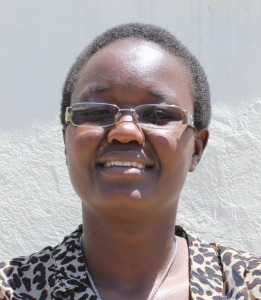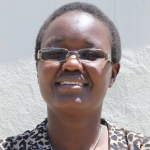"The water looks clean, but it has affected my children because they are always sick of typhoid, and this has drained me financially. Protecting the spring will help me to save money for other things. The spring has a lot of water, and my prayer is for it to be protected soon so that we can forget all the conflicts, sicknesses, and accidents that we have been experiencing," said Mrs. Jacklyne Molenje, a 52-year-old farmer and mother in Indulusia. Jacklyne is also part of the family that owns the land where Molenje Spring is located.
Molenje Spring serves 200 people in Indulusia, but the spring does not meet their needs due to its contaminated water and difficult access point. Consuming the spring's unsafe water consistently brings water-related illnesses to community members, especially affecting their children. The rainy season makes contamination and waterborne illnesses worse as the rains pour farm chemicals, animal waste, dirt, and other toxins straight to the surface runoff source.
Because the spring is open, animals often walk straight into the water while drinking from the pipe, leaving their waste around the spring. Some community members wash their clothes near the spring, too. The surrounding area is therefore not hygienic, further putting community members at risk while they fetch water.
The other main challenge at Molenje Spring is difficulty accessing the drawing point. There is standing water several inches deep, leading away from the source, which community members must stand-in for more than 5 minutes per jerrycan they need to fill. A lack of water does not cause their long wait time, but rather due to the small pipe, they have improvised to force water to flow instead of dribbling down the muddy hill. But the pipe does not capture water from all of the spring's eyes, reducing output and slowing community members down.
The time-consuming process of drawing water at the spring is stressful, and tensions run high as people wait in long lines for their turn to fetch water. Community members report frequent fighting at the spring due to the crowding as neighbors complain of one person taking too long or another bumping into the pipe and stirring up mud and sand into the water in the process. People also report frequent cases of children falling and injuring themselves, trying to get in and out of the spring due to the water-logged area.
"Protecting the spring will help us to fetch water easily. This is because we really suffer as children fetching water since the place is hilly and open simultaneously," said teenager Sheila.
"We will no longer get sick. Rather, we will stay healthy because of accessing clean and safe water," Sheila added, reflecting on what might change if Molenje Spring were protected.
What We Can Do:
Spring Protection
Protecting the spring will help provide access to cleaner and safer water and reduce the time people have to spend to fetch it. Construction will keep surface runoff and other contaminants out of the water. With the community’s high involvement in the process, there should be a good sense of responsibility and ownership for the new clean water source.
Fetching water is a task predominantly carried out by women and young girls. Therefore, protecting the spring and offering training and support will help empower the female members of the community by freeing up more of their time and energy to engage and invest in income-generating activities and their education.
Training on Health, Hygiene, COVID-19, and More
To hold training during the pandemic, we work closely with both community leaders and the local government to approve small groups to attend training. We ask community leaders to invite a select yet representative group of people to attend training, which will then act as ambassadors to the rest of the community to share what they learn. We also communicate our expectations of physical distancing and wearing masks for all who choose to attend.
The training will focus on improved hygiene, health, and sanitation habits in this community. We will also have a dedicated session on COVID-19 symptoms, transmission routes, and prevention best practices.
With the community’s input, we will identify key leverage points to alter their practices at the personal, household, and community levels to affect change. This training will help ensure participants have the knowledge they need about healthy practices and their importance to make the most of their water points as soon as the water is flowing.
Our team of facilitators will use a variety of methods to train community members. Some of these methods include participatory hygiene and sanitation transformation, asset-based community development, group discussions, handouts, and demonstrations at the spring.
One of the most important issues we plan to cover is handling, storing, and treating water. Having a clean water source will be extremely helpful, but it is useless if water gets contaminated by the time it is consumed. The community and we strongly believe that all of these components will work together to improve living standards here, which will help to unlock the potential for these community members to live better, healthier lives.
We will then conduct a small series of follow-up training before transitioning to our regularly scheduled support visits throughout the year.
Training will result in the formation of a water user committee, elected by their peers, that will oversee the spring's operations and maintenance. The committee will enforce proper behavior around the spring and delegate tasks that will help preserve the site, such as building a fence and digging proper drainage channels. The fence will keep out destructive animals and unwanted waste, and the drainage will keep the area’s mosquito population at a minimum.

 Protected Spring
Protected Spring
 Rehabilitation Project
Rehabilitation Project




































